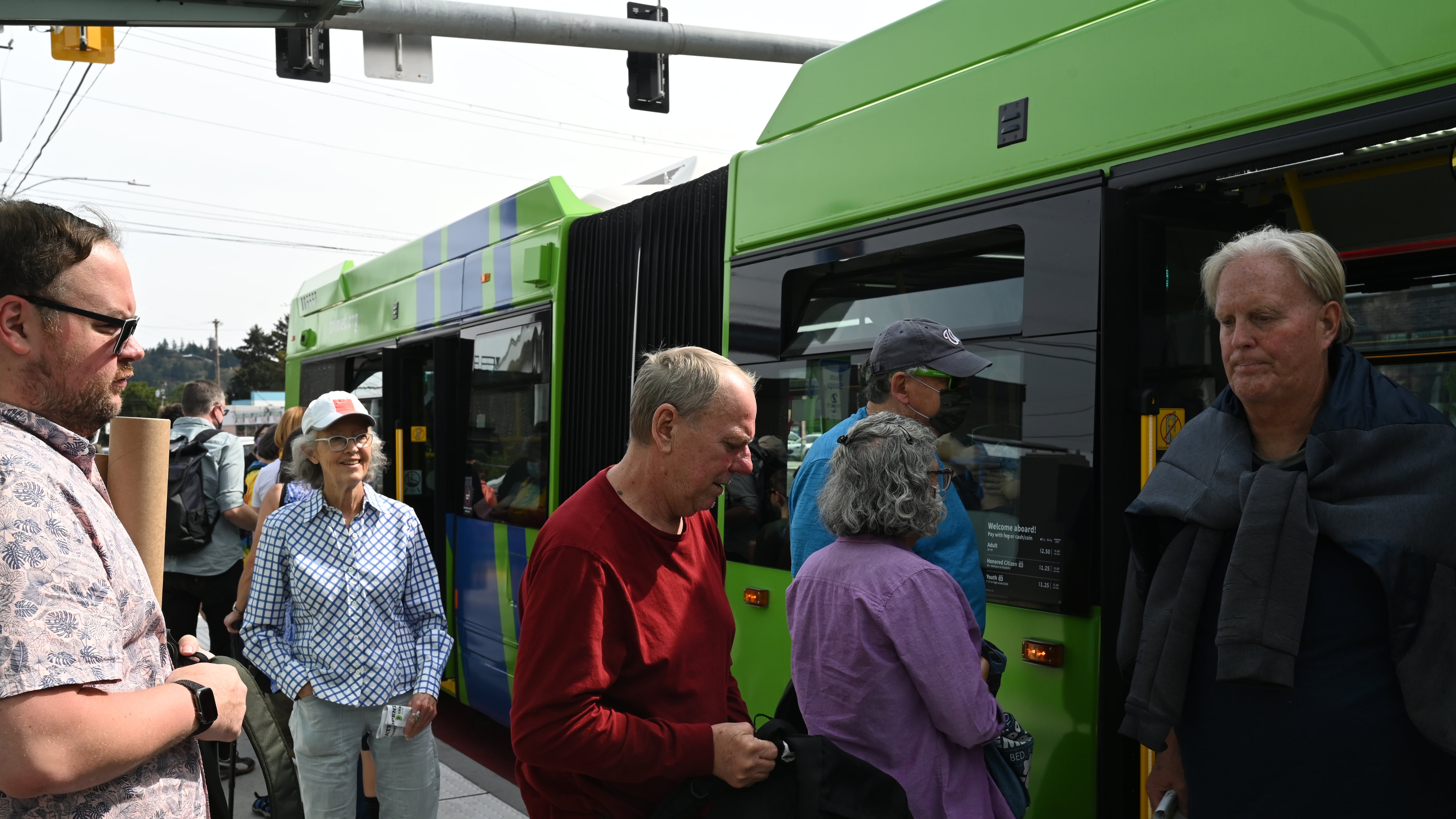In the 1994 Hollywood blockbuster Speed, Sandra Bullock and Keanu Reeves take drastic measures to keep a city bus moving at least 50 miles per hour: blowing red lights, leaping a drawbridge, crashing into a jet plane.
No such fiery dramatics were on view last week as state, city and county leaders converged on Portland Community College’s Southeast campus to celebrate the arrival of TriMet’s long-awaited “Bus Rapid Transit” line on Southeast Division Street.
But Keanu’s old dilemma—keeping the bus moving at a baseline speed—lurked on the edges of the happy scene.
After nine years and $175 million, the Frequent Express 2, or FX2 for short, replaces the existing Line 2 with fewer stops, new 60-foot, articulated buses, and timed signals.
Officials herald the project as a way out of a difficult bind the region’s transit planners now face. As population has increased, ridership has decreased, adding to gridlock. TriMet badly needs new projects like FX2 to lure riders back with the promise of escaping traffic jams in state-of-the-art comfort.
That’s why TriMet promised the new project would result in a faster ride. A Q&A posted on its website in 2016 estimated a 15% to 20% decrease in travel times.
But in order to provide a faster commute, TriMet had to make trade-offs.
The agency abandoned plans to extend the route to Mt. Hood Community College, which would have attracted a new cohort of riders. It also altered the route to run through inner Division after initial plans to use Southeast Powell Boulevard proved too slow and expensive. And it closed dozens of bus stops along Line 2, many in East Portland and Gresham.
For all of that, it’s unclear just how much faster TriMet’s new bus line really is.
Thanks to congestion and other trade-offs forced on the project by TriMet planners, the bus isn’t faster for all trips, WW has found, especially when compared with transit times when the project was first announced.
In 2013, it took at most 66 minutes to travel from Gresham Transit Center to the Taylor Street stop in downtown Portland.
It now takes 67 minutes using the new rapid transit line at peak commute hours.
“That’s freaking hilarious,” says Kem Marks, a transit advocate who served on the project’s steering committee back in 2014. “The whole purpose was to allow people to go farther and go faster.”
To be sure, Line 2 has gotten slower in recent years as Division has developed and the pandemic has sent commuters back to their cars. FX2 is offering relief, says TriMet spokeswoman Roberta Altstadt. “FX is providing faster trips for the vast majority of riders,” she says, pointing to the section of the route between Southeast 82nd and 162nd avenues, which is now 29% faster than the local line.
But in response to questions from WW about whether the line was meeting its speed goals, TriMet said it has been “stepping away” from the 20% claim. The agency no longer contracts with the company that came up with that estimate and could not update it, Altstadt says.
In fact, TriMet no longer wants the line to be called “Bus Rapid Transit,” even though that’s how it referred to the line in its federal grant application and in promotional materials from 2020 on its website.
The term is notoriously difficult to define. People associate BRT with dedicated bus lanes, says Altstadt, which FX2 only has in limited spots.
In 2009, planners at the regional government Metro brainstormed options for expanding high-speed transit in Portland. They made a short list. At the top was the Highway 26 corridor in East Portland.
Rather than pursuing the billions of dollars necessary to build light rail—as the agency tried unsuccessfully to do in 2020 when it attempted to raise money to build a new line to Tualatin—planners focused on improving buses. They would be faster to build and cheaper.
Metro then convened a steering committee of 22 local politicians, policymakers and community advocates. They spent two years hammering out the details with TriMet planners.
The committee quickly settled on a “preferred” route, which would extend the line from Mt. Hood Community College to the South Waterfront. Key to the route’s success, committee members said in a meeting summary, was a “discernibly quicker trip.”
Achieving this, planners quickly realized, was going to be a challenge. Despite the dedicated bus lane, the detour along the South Waterfront cost time. As did maneuvering buses on congested 82nd Avenue to get to Powell Boulevard.
Planners warned the committee the new line was projected to be slower than the line it replaced, members of the committee told WW.
To compete for a federal grant, TriMet needed the new FX2 line to go faster than the old Division Street Line 2 it replaced, while staying under budget. So it removed the Powell Boulevard diversion and, as a cost-saving measure, cut the Mt. Hood Community College extension.
The result? Buses move faster up and down Division, at least until they hit the detour across the Tilikum Crossing bridge or freight traffic on the Pacific Union tracks.
But these advantages came at a cost: Bus stops disappeared.
This was a contentious issue back in 2015 as Metro planned the line. “We heard person after person after person come and speak to the steering committee about how they didn’t want to lose stops that were right near their house,” says Michael Calcagno, a former board member at Mt. Hood Community College and member of the steering committee.
TriMet planners took the criticism seriously but pointed out that speeding up the bus was necessary to win federal funding. Without removing stops, Calcagno recalls, “there would be no rapid transit line because we would have no federal funding. The testimony was sort of moot.”
TriMet says the eliminated stops have had minimal effects. “All but 1% of riders will find a station within a few blocks of their current stop,” the agency claims.
But Gresham blocks can be long, and the lost stops had a big effect on John Bildsoe’s household. He represented the Gresham Coalition of Neighborhood Associations on the steering committee and lives by one of the eliminated stops. Before FX2, his kids walked to the bus stop to ride to PCC and Portland State University.
But that stop is gone, and the result, at least for the Bildsoe family, is fewer bus riders.
“I’m finding it cheaper and faster to get cars for my kids,” Bildsoe says.
Vivian Satterfield, who sat on the committee and is now a director at the nonprofit Verde, explains why she ultimately supported the compromise. “I’m never going to vote against transit,” Satterfield says, “especially when this region is looking to expand our public transit capacity by applying for federal funds.”
But aspects of the final proposal still bug her. She thinks a lack of dedicated bus lanes along the entire route and the decision to divert away from Mt. Hood Community College and Powell Boulevard are going to prove significant hurdles to increased ridership.
“We need people to ride transit,” Satterfield says, but she remains “unconvinced” the new line can attract enough ridership to “show success” for the BRT concept.
For Duncan Hwang, a director at the Asian Pacific American Network of Oregon, the benefits of the project are broader than just a faster bus.
“When viewed holistically as a community development project rather than just a transit project, we got some real benefits for East Portland,” he says.
He ticked off wins: The contract to build the project went to a majority Black company, Raimore Construction. New sidewalks and lighting have made Division Street safer and more walkable. Mt. Hood Community College won concessions as well, including faster service on a neighboring bus line.
On a recent Friday afternoon, commuters on FX2′s Bus 4523 said they were pleased with the new service. The buses were clean and spacious— and at least somewhat faster.
Jason Rohman was coming back from his job at an environmental restoration firm in Tigard. The new route had shaved six minutes off his commute, he said.
That afternoon, Todd Pomerening was behind the wheel. He used to drive the line when it was a local route and said the new express service was an improvement.
The biggest complaint he heard from riders was the eliminated stops.
“Overall, I think it’s going to be much better,” Pomerening said, “at least once people get used to it.”

